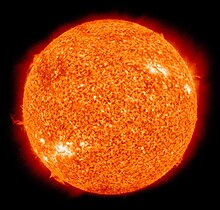
Sun
star at the centre of the Solar System / From Wikipedia, the free encyclopedia
The Sun, also known as Sol, is a star at the center of the solar system. It is a white powerfully made by nature star that gives off different types of energy such as infrared energy (heat), ultraviolet light, radio waves and light. It also gives off a stream of particles, which reaches Earth as "solar wind". The source of all this energy is nuclear fusion. Nuclear fusion is the reaction in the star which turns hydrogen into helium and makes huge amounts of energy. It is a nearly perfect ball of hot plasma.
 | |
 False-color photo of the Sun as seen in ultraviolet light (wavelength of 30.4 nm) | |
| Observation data | |
|---|---|
| Mean distance from Earth | 1 au ≈ 1.496×108 km[1] 8 min 19 s at light speed |
| Visual brightness (V) | −26.74[2] |
| Absolute magnitude | 4.83[2] |
| Spectral classification | G2V[3] |
| Metallicity | Z = 0.0122[4] |
| Angular size | 31.6–32.7 minutes of arc[5] |
| Adjectives | Solar |
| Orbital characteristics | |
| Mean distance from Milky Way core | ≈ 2.7×1017 km 27,200 light-years |
| Galactic period | (2.25–2.50)×108 yr |
| Velocity | ≈ 220 km/s (orbit around the center of the Milky Way) ≈ 20 km/s (relative to average velocity of other stars in stellar neighborhood) ≈ 370 km/s[6] (relative to the cosmic microwave background) |
| Physical characteristics | |
| Equatorial radius | 695,700 km,[7] 696,342 km[8] 109 × Earth[9] |
| Equatorial circumference | 4.379×106 km[9] 109 × Earth[9] |
| Flattening | 9×10−6 |
| Surface area | 6.09×1012 km2[9] 12,000 × Earth[9] |
| Volume | 1.41×1018 km3[9] 1,300,000 × Earth |
| Mass | 1.9885×1030 kg[2] 333,000 × Earth[2] |
| Average density | 1.408 g/cm3[2][9][10] 0.255 × Earth[2][9] |
| Center density (modeled) | 162.2 g/cm3[2] 12.4 × Earth |
| Equatorial surface gravity | 274 m/s2[2] 28 × Earth[9] |
| Moment of inertia factor | 0.070[2] (estimate) |
| Escape velocity (from the surface) | 617.7 km/s[9] 55 × Earth[9] |
| Temperature | Center (modeled): 1.57×107 K[2] Photosphere (effective): 5,778 K[2] Corona: ≈ 5×106 K |
| Luminosity (Lsol) | 3.828×1026 W[2] ≈ 3.75×1028 lm ≈ 98 lm/W efficacy |
| Color (B-V) | 0.63 |
| Mean radiance (Isol) | 2.009×107 W·m−2·sr−1 |
| Age | ≈ 4.6 billion years[11][12] |
| Rotation characteristics | |
| Obliquity | 7.25°[2] (to the ecliptic) 67.23° (to the galactic plane) |
| Right ascension of North pole[13] | 286.13° 19 h 4 min 30 s |
| Declination of North pole | +63.87° 63° 52' North |
| Sidereal rotation period (at equator) | 25.05 d[2] |
| (at 16° latitude) | 25.38 d[2] 25 d 9 h 7 min 12 s[13] |
| (at poles) | 34.4 d[2] |
| Rotation velocity (at equator) | 7.189×103 km/h[9] |
| Photospheric composition (by mass) | |
| Hydrogen | 73.46%[14] |
| Helium | 24.85% |
| Oxygen | 0.77% |
| Carbon | 0.29% |
| Iron | 0.16% |
| Neon | 0.12% |
| Nitrogen | 0.09% |
| Silicon | 0.07% |
| Magnesium | 0.05% |
| Sulfur | 0.04% |

The Sun looks yellow to a person standing on the Earth, but it is actually white. It looks yellow from the ground because the Earth's atmosphere scatters sunlight, causing shorter blue and green wavelengths to disperse, making the Sun's remaining visible light appear more yellow.
The Sun is a star like many others in our Milky Way galaxy. The Sun is a type of star called a G-type main-sequence star based on its spectral class.[15]
The Sun has existed for a little over 4.5 billion years.
The Sun is about a hundred times as wide as the Earth. It has a mass of 1.9891×1030 kg. This is 333,000 times the mass of the Earth. 1.3 million Earths can fit inside the Sun.[16] The Sun fuses about 600 million tons of hydrogen into helium every second.
The Sun is the main source of energy for the Earth. This energy is made deep inside the Sun in a process called nuclear fusion. Four hydrogen atoms are fused together to make one helium atom. Some of the leftover matter turns into energy. This is the same way energy is released in a hydrogen bomb.
It can take between 10,000 and 170,000 years for the energy in the core of the Sun to escape.